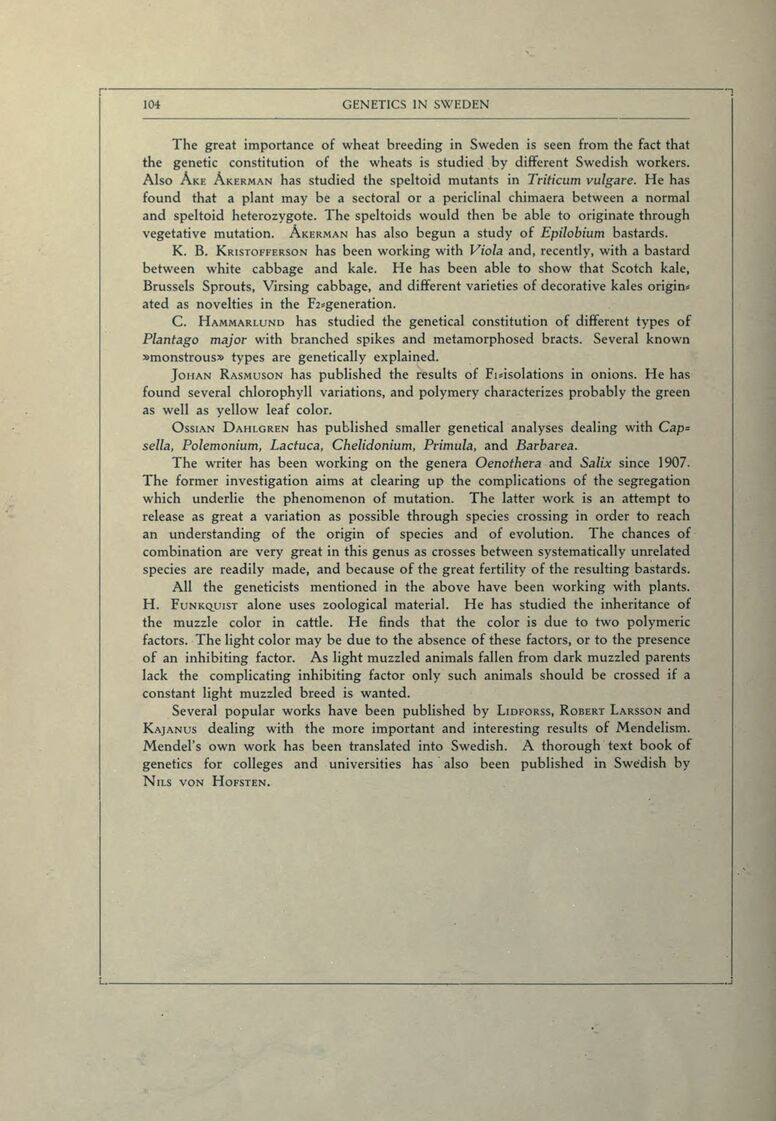
Full resolution (JPEG) - On this page / på denna sida - Part I - Docent N. Heribert-Nilsson, Lund, Genetics in Sweden

<< prev. page << föreg. sida << >> nästa sida >> next page >>
Below is the raw OCR text
from the above scanned image.
Do you see an error? Proofread the page now!
Här nedan syns maskintolkade texten från faksimilbilden ovan.
Ser du något fel? Korrekturläs sidan nu!
This page has never been proofread. / Denna sida har aldrig korrekturlästs.
The great importance of wheat breeding in Sweden is seen from the faet that
the genetic constitution of the wheats is studied by different Swedish workers.
Also Åke Åkerman has studied the speltoid mutants in Triticum vulgare. He has
found that a plant may be a sectoral or a periclinal chimaera between a normal
and speltoid heterozygote. The speltoids would then be able to originate through
vegetative mutation. Åkerman has also begun a study of Epilobium bastards.
K. B. Kristofferson has been working with Viola and, recently, with a bastard
between white cabbage and kale. He has been able to show that Scotch kale,
Brussels Sprouts, Virsing cabbage, and different varieties of decorative kales origim
ated as novelties in the F2=generation.
C. Hammarlund has studied the genetical constitution of different types of
Plantago major with branched spikes and metamorphosed bracts. Several known
»monstrous» types are genetically explained.
Johan Rasmuson has published the results of Fidsolations in onions. He has
found several chlorophyll variations, and polymery characterizes probably the green
as well as yellow leaf color.
Ossian Dahlgren has published smaller genetical analyses dealing with Cap=
sella, Polemonium, Lactuca, Chelidonium, Primula, and Barbarea.
The writer has been working on the genera Oenothera and Salix since 1907.
The former investigation aims at clearing up the complications of the segregation
which underlie the phenomenon of mutation. The latter work is an attempt to
release as great a variation as possible through species Crossing in order to reach
an understanding of the origin of species and of evolution. The chances of
combination are very great in this genus as crosses between systematically unrelated
species are readily made, and because of the great fertility of the resulting bastards.
All the geneticists mentioned in the above have been working with plants.
H. Funkquist alone uses zoological material. He has studied the inheritance of
the muzzle color in cattle. He finds that the color is due to two polymeric
factors. The light color may be due to the absence of these factors, or to the presence
of an inhibiting factor. As light muzzled animals fallen from dark muzzled parents
lack the complicating inhibiting factor only such animals should be crossed if a
constant light muzzled breed is wanted.
Several popular works have been published by Lidforss, Robert Larsson and
Kajanus dealing with the more important and interesting results of Mendelism.
Mendel’s own work has been translated into Swedish. A thorough text book of
genetics for colleges and universities has also been published in Swedish by
Nils von Hofsten.
<< prev. page << föreg. sida << >> nästa sida >> next page >>